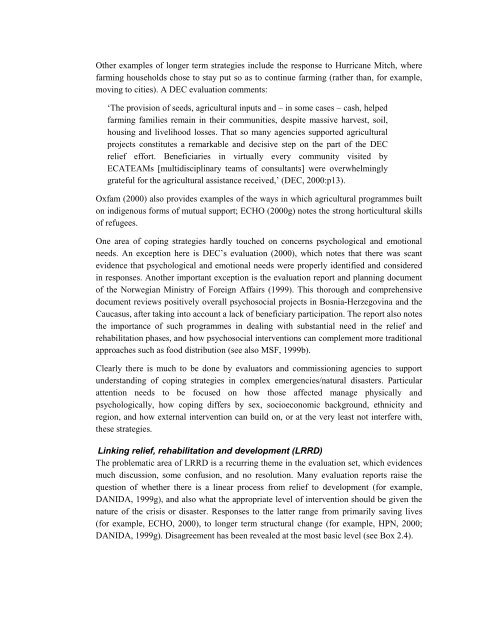Download PDF - ReliefWeb
Download PDF - ReliefWeb
Download PDF - ReliefWeb
Create successful ePaper yourself
Turn your PDF publications into a flip-book with our unique Google optimized e-Paper software.
Other examples of longer term strategies include the response to Hurricane Mitch, where<br />
farming households chose to stay put so as to continue farming (rather than, for example,<br />
moving to cities). A DEC evaluation comments:<br />
‘The provision of seeds, agricultural inputs and – in some cases – cash, helped<br />
farming families remain in their communities, despite massive harvest, soil,<br />
housing and livelihood losses. That so many agencies supported agricultural<br />
projects constitutes a remarkable and decisive step on the part of the DEC<br />
relief effort. Beneficiaries in virtually every community visited by<br />
ECATEAMs [multidisciplinary teams of consultants] were overwhelmingly<br />
grateful for the agricultural assistance received,’ (DEC, 2000:p13).<br />
Oxfam (2000) also provides examples of the ways in which agricultural programmes built<br />
on indigenous forms of mutual support; ECHO (2000g) notes the strong horticultural skills<br />
of refugees.<br />
One area of coping strategies hardly touched on concerns psychological and emotional<br />
needs. An exception here is DEC’s evaluation (2000), which notes that there was scant<br />
evidence that psychological and emotional needs were properly identified and considered<br />
in responses. Another important exception is the evaluation report and planning document<br />
of the Norwegian Ministry of Foreign Affairs (1999). This thorough and comprehensive<br />
document reviews positively overall psychosocial projects in Bosnia-Herzegovina and the<br />
Caucasus, after taking into account a lack of beneficiary participation. The report also notes<br />
the importance of such programmes in dealing with substantial need in the relief and<br />
rehabilitation phases, and how psychosocial interventions can complement more traditional<br />
approaches such as food distribution (see also MSF, 1999b).<br />
Clearly there is much to be done by evaluators and commissioning agencies to support<br />
understanding of coping strategies in complex emergencies/natural disasters. Particular<br />
attention needs to be focused on how those affected manage physically and<br />
psychologically, how coping differs by sex, socioeconomic background, ethnicity and<br />
region, and how external intervention can build on, or at the very least not interfere with,<br />
these strategies.<br />
Linking relief, rehabilitation and development (LRRD)<br />
The problematic area of LRRD is a recurring theme in the evaluation set, which evidences<br />
much discussion, some confusion, and no resolution. Many evaluation reports raise the<br />
question of whether there is a linear process from relief to development (for example,<br />
DANIDA, 1999g), and also what the appropriate level of intervention should be given the<br />
nature of the crisis or disaster. Responses to the latter range from primarily saving lives<br />
(for example, ECHO, 2000), to longer term structural change (for example, HPN, 2000;<br />
DANIDA, 1999g). Disagreement has been revealed at the most basic level (see Box 2.4).
















![CynefinFramework final [Read-Only]](https://img.yumpu.com/19017304/1/190x135/cynefinframework-final-read-only.jpg?quality=85)